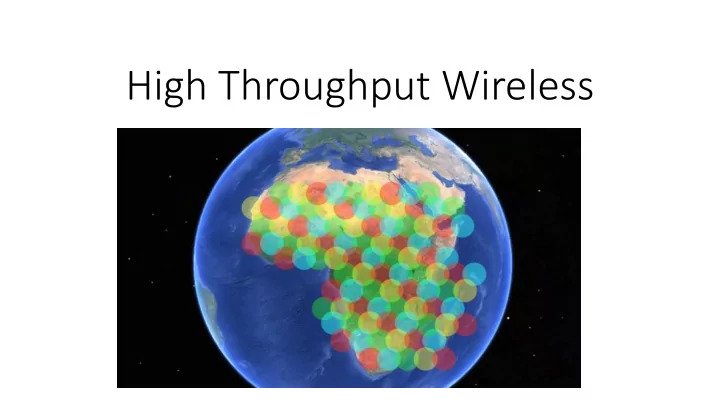

High Throughput Wireless
66cm Antenna 99% Availability Ka-band 1.0% VIASAT-1 2.1% 4.2% 8.3% 16.7% 33.3% 50.0% 100.0% Beam Coverage 1.0% 1.5% 2.1% 4.2% 8.3% 16.7% 33.3% 50.0% 100.0% Total Coverage 100% 100% 100% 100% 100% 100% 100% 100% 100% User Beams 96 68 48 24 12 6 3 2 1 Transponders 96 68 48 24 12 6 3 2 1 Xpdr BW 112 MHz 112 MHz 112 MHz 112 MHz 112 MHz 112 MHz 112 MHz 112 MHz 112 MHz BW 125 MHz 125 MHz 125 MHz 125 MHz 125 MHz 125 MHz 125 MHz 125 MHz 125 MHz Xpndr per Beam 6 6 6 6 6 6 6 6 6 Pols per Beam 2 2 2 2 2 2 2 2 2 BW per Beam 1500 MHz 1500 MHz 1500 MHz 1500 MHz 1500 MHz 1500 MHz 1500 MHz 1500 MHz 1500 MHz Total BW 144000 MHz 102000 MHz 72000 MHz 36000 MHz 18000 MHz 9000 MHz 4500 MHz 3000 MHz 1500 MHz Total BW 144.0 GHz 102.0 GHz 72.0 GHz 36.0 GHz 18.0 GHz 9.0 GHz 4.5 GHz 3.0 GHz 1.5 GHz Total Capacity 107.5 GBps 95.4 GBps 82.0 GBps 53.4 GBps 39.6 GBps 25.0 GBps 14.2 GBps 10.1 GBps 5.6 GBps Bits/Hz 0.75 0.94 1.14 1.48 2.20 2.77 3.16 3.37 3.73
Broadband Fundamentals • Frequency spectrum allocation • Frequency reuse • Bits /Hz (high order modulation) • These elements drive the solution toward higher frequencies
Frequency Reuse through Contention • Committed Information Rate CIR is a QOS that allows the use of contention and guarantees throughput availability. • CIR = 20 Mbps 99% of the time. • Valid comparisons need to include CIR • FTTH uses passive fiber with a typical contention ratio of 32 to 1 • FTTH is a preemptive technology
Frequency Reuse in HTS
In Cellular
Alternate Wireless Delivery Systems • HALO, LEO, MEO Support regional applications • FTTA, Ka band cellular wireless derived from LMDS
In Fiber
Fundamental Economics of HTS • The cost of the satellite is not controlled by the number of beams but more by the total power and weight. • Advances in amplifier technology allow more power to be placed in orbit making it feasible to create many beams • In Satellite design we can optimize for coverage or for thru put • Higher Frequencies (Ka band) make it easier to create many beams
Satellite Architectures • Global Beam • Maximizes coverage • Highest cost for unicast bandwidth • Most Favorable application is broadcasting • Spot Beam (HTS) • Lowest cost and highest capacity for unicast
Global beam broadcast • Very powerful for delivering BW in the form of high demand broadcast media • Can get the same source BW delivered millions of times • Best possible application for Global Beam • Next is universal coverage • Simple Network Architecture
Spot Beam HTS • Highest capacity lowest cost unicast BW • Allows specific market grooming • Steerable arrays and on board processing allow adaptable cell structures and beam size.
Price Points • HTS • CPE 40 by 20 Mbps at $400 • Bandwidth $5 per Gb (similar to cellular rates) • CIR not usually specified • LTE • Customer Terminal $100 to &1000 • Bandwidth $5 per GB (AT&T) • CIR not usually specified.
Recommend
More recommend